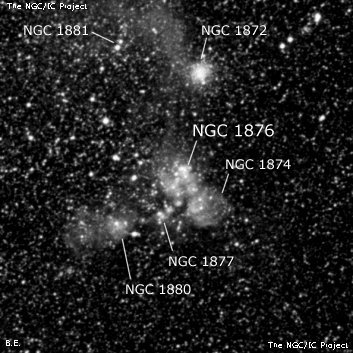
James Dunlop probably discovered NGC 1876 = h2804 = D 122? and described "a small nebula, about 20" diameter, with three smaller nebulae following, and three pretty bright small stars on the north side". His position of 14' S of the NGC 1874/1876/1877/1880 complex, so he probably saw several or all of these.
John Herschel independently discovered NGC 1876 = h2804 on 3 Nov 1834 and described as "B, irreg R (the following of two very close) connected by an arc-formed cluster with another." On his second he logged "pB, r, the most compressed part of an irregular binuclear nebula which terminates, to the south, an arc-formed cluster." His mean position from 4 sweeps is accurate and a sketch showing the entire complex is on plate III, figure 6.
600/800mm - 24" (4/5/08 - Magellan Observatory, Australia): this is the largest and brightest in an impressive complex of HII regions just 3' S of the blue globular NGC 1872. At 200x and a UHC filter it appeared very bright with a slightly irregular outline, ~1.2' diameter, brightest along the north rim where there is a brighter knot. NGC 1874, another bright section, lies only 1' SW and NGC 1877 is a similar distance south-southeast. A long curving chain of stars sweeps to the NE of the complex (stellar association LH 35). NGC 1881 lies the north end of this stellar chain.
Notes by Steve Gottlieb